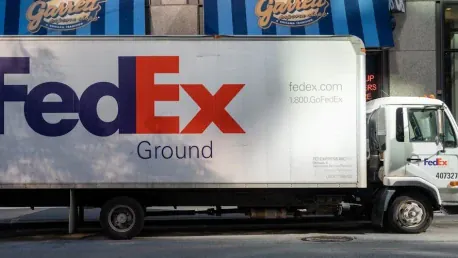FedEx Corporation has recently made waves in the business world by announcing a strategic corporate restructuring move: separating its less-than-truckload (LTL) subsidiary, FedEx Freight, into a standalone publicly traded entity. This significant decision, set to be implemented over the next 18 months, is expected to unlock sustainable shareholder value while being tax-efficient for FedEx stockholders. In a move designed to bolster operational focus and agility, the separation will allow both entities to thrive independently, each concentrating on its core competencies.
Strategic Decision-Making and Rationale
The choice to separate FedEx Freight from the broader FedEx portfolio emerges from ongoing evaluations aimed at optimizing the subsidiary’s role and enhancing shareholder value. FedEx’s leadership is confident that creating a standalone entity will allow for improved operational focus and accountability, making the organization more agile and better positioned to meet customer demands. This restructuring effort aligns well with FedEx’s broader goals of streamlining operations to respond more effectively to market dynamics and maintain a competitive edge.
FedEx executives believe that the separation allows each entity to concentrate on their unique strengths and markets, thus driving better performance and growth. With clearer focus and dedicated management, the strategic rationale aims to create two industry-leading public companies. This structure is anticipated to provide FedEx Freight with the operational freedom necessary to pursue its strategic targets independently, leading to enhanced efficiency and responsiveness to market trends.
Historical Context of FedEx Freight
FedEx Freight boasts a rich history that dates back to the early 2000s, having emerged from the acquisitions of American Freightways, Viking Freight, and Watkins Motor Lines in 2001. Over the ensuing years, FedEx Freight has developed into the largest LTL carrier in the United States, playing a pivotal role in FedEx’s comprehensive logistics and transportation network. This growth trajectory has cemented its position as a crucial component of the overall FedEx portfolio.
Financially, FedEx Freight has experienced both peaks and valleys, with its peak revenue recorded in 2022 demonstrating its significant contribution to FedEx’s overall performance. However, the subsequent dip in revenue in 2023 highlighted underlying challenges faced by the subsidiary, underscoring the need for a strategic reevaluation of its role within FedEx. This historical perspective provides context to the importance and complexity of spinning off FedEx Freight as an independent entity.
Financial Performance and Market Position
Examining FedEx Freight’s financial performance over recent years reveals a blend of growth and challenges characteristic of the competitive and dynamic LTL market. The fiscal 2024 revenue figures indicate a year-over-year decline, reflecting the fluctuating nature of the industry. Notwithstanding this recent dip in revenues, FedEx Freight still maintains a leading position in the U.S. LTL segment.
The decision to create a standalone company is expected to grant FedEx Freight the flexibility to make strategic investments and capital allocations independently. This autonomy is anticipated to fortify its market position and enable it to respond more promptly and effectively to customer demands and evolving market trends. By unlocking the subsidiary’s full potential, the move aims to drive long-term growth and bolster FedEx Freight’s position within the industry.
Benefits of Separation
The transformation of FedEx Freight into an independent entity is viewed as a strategic initiative poised to create industry-leading public companies. One of the anticipated benefits of this new alignment is enhanced operational freedom, allowing for more tailored customer and market focus. Further, this separation is expected to offer greater flexibility in investments and capital allocations, empowering FedEx Freight to pursue strategic opportunities.
Operating as a standalone company will afford FedEx Freight the opportunity to fine-tune its operations and concentrate on its core competencies. This operational freedom is predicted to result in increased efficiency and effectiveness in meeting customer needs. Additionally, being an independent entity is expected to boost FedEx Freight’s capacity for innovation and adaptability to changing market conditions. These benefits collectively aim to position FedEx Freight favorably within its sector while fostering growth and improved performance.
Challenges and Competitive Landscape
While the separation presents several opportunities, it is accompanied by its share of challenges. One primary challenge lies in the necessity of establishing dedicated support functions such as human resources, sales force, and administrative departments. These new cost structures and operating ratios must be carefully managed to ensure a smooth transition and maintain operational efficiency.
Navigating the competitive landscape of the LTL market post-separation will be another significant hurdle for FedEx Freight. The company needs to uphold its leading market position while adapting to more competitive market dynamics. This will call for strategic planning and adept execution to guarantee that FedEx Freight not only maintains its strength within the LTL segment but also thrives amidst intensifying competition. Addressing these challenges will be crucial for the success of the newly independent FedEx Freight.
Market Reactions and Expert Opinions
The announcement of the separation has sparked varied reactions from market analysts and industry experts. Many analysts perceive the move in a positive light, underscoring the potential benefits of FedEx Freight’s newfound autonomy. They posit that the separation will enable the subsidiary to channel its efforts toward strategic targets, potentially driving improved performance and growth.
However, some experts have sounded a note of caution, expressing concerns about the operational challenges that might arise during and post-separation. They emphasize that the transition must be delicately managed to prevent disruptions, ensuring both entities operate smoothly and effectively. Despite these reservations, the overall sentiment among analysts and industry observers remains optimistic about the potential advantages resulting from the separation.
Overarching Trends and Consensus Viewpoints
FedEx Corporation has drawn major attention in the business world with its announcement of a strategic corporate restructuring: separating its less-than-truckload (LTL) subsidiary, FedEx Freight, into a standalone publicly traded company. This crucial move, scheduled to be carried out over the next 18 months, aims to maximize sustainable shareholder value while maintaining tax efficiency for FedEx stockholders. By splitting FedEx Freight into an independent entity, the company anticipates enhanced operational focus and agility. This separation will enable each entity to concentrate on its core competencies, allowing them to thrive independently. FedEx aims to streamline operations, fostering growth and unlocking potential opportunities in their respective markets. As the operational landscape evolves, this strategic decision reflects FedEx’s commitment to adapting and optimizing its business structure for future growth. This move is expected to bolster the company’s ability to navigate market fluctuations and respond to industry demands more effectively.









